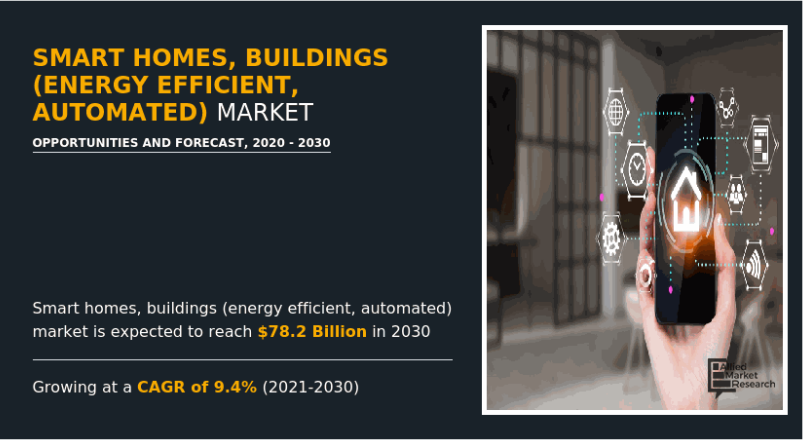
What Will Smart Homes, Buildings Market Look Like In The Future?

Smart Homes, Buildings
Smart Homes, Buildings Market is anticipated to surpass USD 78.2 billion by 2030
OREGON, PORTLAND, UNITED STATES, June 29, 2023/EINPresswire.com/ --
Smart Homes, Buildings Industry Overview
The global Smart Homes, Buildings Market size was valued at $32.0 billion in 2020, and is estimated to reach $78.2 billion by 2030, growing at a CAGR of 9.4% from 2021 to 2030.
Smart homes and smart buildings refer to residential and commercial structures, respectively, that incorporate advanced technologies and systems to enhance comfort, convenience, energy efficiency, security, and overall automation. These systems utilize internet connectivity and intelligent devices to enable remote monitoring, control, and automation of various functions within the home or building.
Get Free Sample PDF @ https://www.alliedmarketresearch.com/request-sample/79
Smart homes and buildings integrate automation systems that enable centralized control of various devices and systems, such as lighting, HVAC (heating, ventilation, and air conditioning), security systems, appliances, and entertainment systems. This allows users to manage and customize their settings remotely through smartphones, tablets, or voice assistants.
Key factors responsible for the smart homes, buildings (energy efficient, automated) market growth include remote control of home functions, increased energy efficiency, and improved appliance functionality.
Key players profiled in this report include Cisco Systems, Inc., Control4 Corporation, Leviton MFG. Company Inc., Schneider Electric SA, Siemens Building Technologies, United Technologies Corporation, Honeywell Scanning & Mobility, Smarthome, Inc., Emerson Electric Co., and LG Electronics Inc.
Smart energy management systems monitor and optimize energy usage to improve efficiency and reduce costs. This includes features like programmable thermostats, smart lighting with occupancy sensors, energy monitoring and reporting, and integration with renewable energy sources like solar panels.
Smart homes are a priority area of strategic energy planning and national policy. Adoption of smart home technologies (SHTs) relies on prospective users perceiving clear benefits with acceptable levels of risk.
Asia-Pacific registered highest market share, and is projected to maintain the same during the forecast period.
On the basis of application, the lightning control segment emerged as the global leader in 2020, and is anticipated to be the largest market during the forecast period.
Depending on the technology, the Wi-Fi segment emerged as the global leader in 2020, and is anticipated to be the largest market during the forecast period.
Buy This Report (300 Pages PDF with Insights, Charts, Tables, and Figures): https://bit.ly/3ZdTg4a
The residential segment emerged as the global leader in 2020, and is anticipated to be the largest market during the forecast period.
Significant installation costs, reliable internet connection, security issues, and technological problems in connected homes act as restrains for the market growth.
A part of the internet of things (IoT), smart home systems, and devices often operate together sharing consumer usage data among themselves and automating actions based on preferences of homeowners.
A smart home is a residence that uses internet-connected devices to enable remote monitoring and management of appliances and systems, such as lighting and heating.
Smart home technology, also often referred to as home automation or domotics (from the Latin "domus" meaning home), provides homeowners security, comfort, convenience, and energy efficiency by allowing them to control smart devices, often by a smart home app on their smartphones or other networked devices.
Sales of smart homes, buildings (energy efficient, automated) gadgets is directly proportional to the sales of electronic gadgets. Disrupted import & export activities led to decline in production of such gadgets, which, in turn, led to decline in growth of the smart homes, buildings (energy efficient, automated) market.
The COVID-19 pandemic has had a significant impact on the construction sector. COVID-19 outbreak have severely disrupted the economy, with devastating effects on global trade and it has simultaneously affected households, businesses, financial institution, industrial establishments, and infrastructure companies.
Make an Inquiry before Buying @ https://www.alliedmarketresearch.com/purchase-enquiry/79
According to the United Nations Industrial Development Organization (UNIDO), 30.0%–70.0% of pre-COVID-19 workforce of various industries, such as electrical and other third-party vendors migrated to their hometowns, owing to uncertainties and loss of income during the lockdown.
Similar Reports:-
Interior Lighting Market by Type (General Lighting, Ambient Lighting, Task Lighting, Mood Lighting, Accent Lighting), by Product (Decorative Lamps, Ceiling Lights, Pendant Lights, Chandeliers, Wall Lights, Clamp Lights, Spots and Spotlights, Step Lights, Track Lights, Recessed and Surface-Mounted Lights, Others), by Lighting Effect (Downlighting, Uplighting, Wall Washing, Wall Grazing, Spotlighting, Perimeter Lighting, Others), by End Use (Residential, Commercial, Others): Global Opportunity Analysis and Industry Forecast, 2023-2032
Commercial Water Heater Market by Type (Electric, Gas, Oil, Solar, Hybrid, Others), by Storage Capacity (Below 500 liters, 500-1000 liters, 1000-3000 liters, 3000-4000 liters, 4000 and Above), by Rated Capacity (0-10 kW, 10-50 kW, 50-100 kW, Above 100 kW): Global Opportunity Analysis and Industry Forecast, 2023-2032
David Correa
Allied Analytics LLP
+ 1-800-792-5285
email us here
EIN Presswire does not exercise editorial control over third-party content provided, uploaded, published, or distributed by users of EIN Presswire. We are a distributor, not a publisher, of 3rd party content. Such content may contain the views, opinions, statements, offers, and other material of the respective users, suppliers, participants, or authors.

